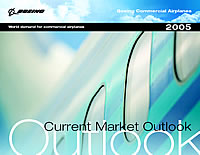Current Market Outlook; Boeing, 2005 |
 |
Boeing said that by 2024 it projects that around 58% of the global fleet will be single-aisle jets and 22% will be midsize twin-aisle airplanes. The balance will consist of regional jets (16%) and some 747-sized and larger airplanes (4%) |
| • For the full report, click here |
| Download Adobe Acrobat Reader |
INTERNATIONAL. Aircraft manufacturing giant Boeing this month issued its much-respected annual “˜Current Market Outlook’, one that paints a rosy picture of the aviation industry’s prospects.
In a report that will be mandatory reading for those involved in travel-related industries such as travel retail Boeing says that the worldwide airline fleet will grow to 35,300 airplanes in 2024 – more than double the current size.
“The long-term outlook for air travel is robust. The fundamentals of economic development, globalization and the need for people to travel will be strong in the coming decades,” the company said. “Although the industry does experience short-terms highs and lows, the long-term forecast assumes that these cycles will smooth out over the 20-year period.”
It said that air transportation demand is driven by economic growth. Increases in GDP explain most of air travel growth, it added. “The rest of the development of travel worldwide is derived from economic factors such as international trade and globalization, and industry trends such as declining fares, more direct service and increased frequencies.”
Boeing said that by 2024 it projects that around 58% of the global fleet will be single-aisle jets and 22% will be midsize twin-aisle airplanes. The balance will consist of regional jets (16%) and some 747-sized and larger airplanes (4%).
Regionally, Boeing said that developing economies in Asia Pacific and Latin America will foster significant growth in airline travel throughout the forecast period. Within China, for example, an annualized GDP growth rate of +6% will produce +8.8% yearly traffic growth. Some flows, such as Europe to Asia Pacific, will especially benefit from the availability of advanced long-range airplanes. “Globalization is also leading to the development of new hubs and the growth of corresponding traffic flows, such as Middle East to Asia Pacific.”
The more mature economies will also grow, albeit more slowly, Boeing commented. Traffic within North America and Europe will grow at +3.5% and +3.4% respectively on an annual basis.
Economic and traffic growth 2005-2024
– Worldwide economic growth will average +2.9% per year
– Passenger traffic will average +4.8% per year
– Cargo traffic growth will average +6.2% per year




